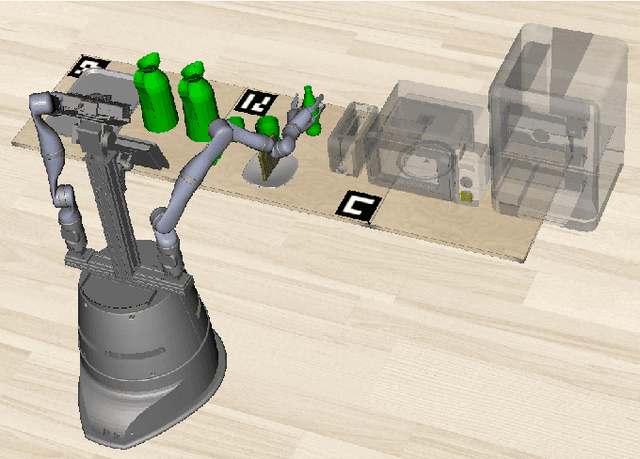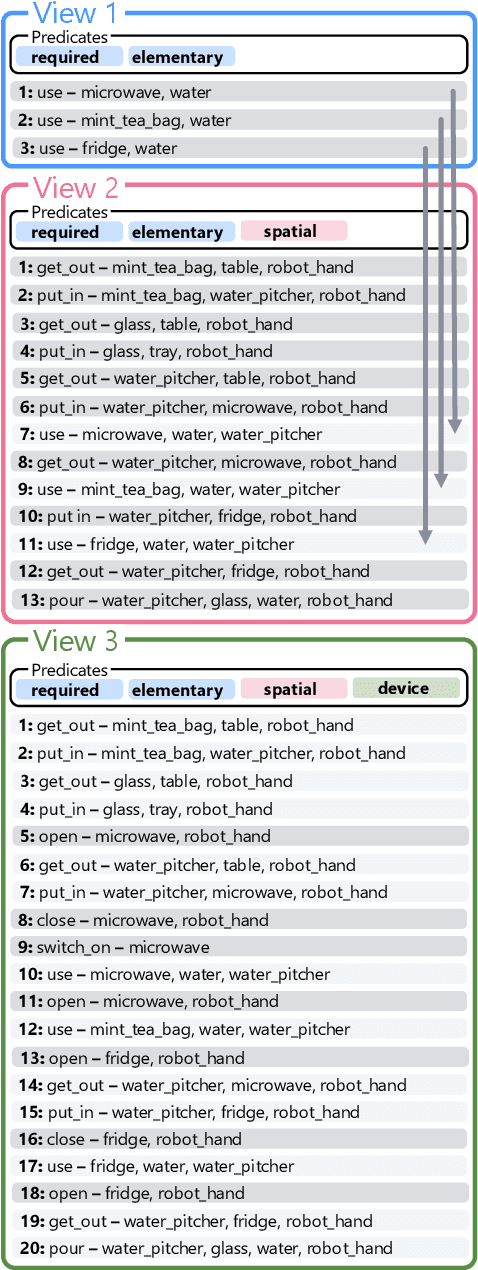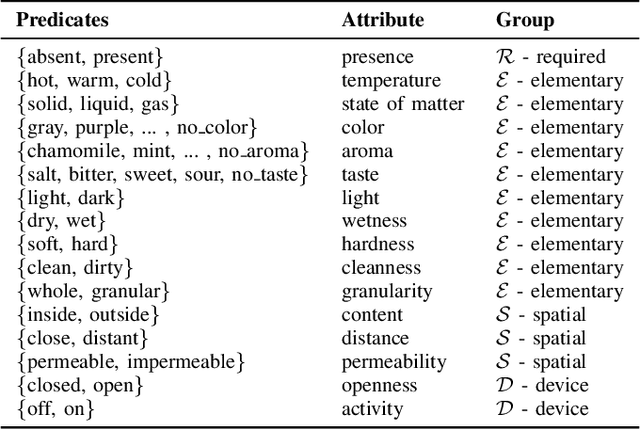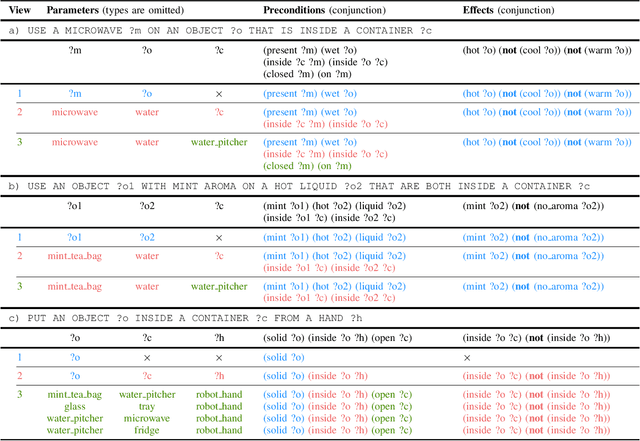Michael Gienger
Bimanual Robot-Assisted Dressing: A Spherical Coordinate-Based Strategy for Tight-Fitting Garments
Aug 17, 2025Abstract:Robot-assisted dressing is a popular but challenging topic in the field of robotic manipulation, offering significant potential to improve the quality of life for individuals with mobility limitations. Currently, the majority of research on robot-assisted dressing focuses on how to put on loose-fitting clothing, with little attention paid to tight garments. For the former, since the armscye is larger, a single robotic arm can usually complete the dressing task successfully. However, for the latter, dressing with a single robotic arm often fails due to the narrower armscye and the property of diminishing rigidity in the armscye, which eventually causes the armscye to get stuck. This paper proposes a bimanual dressing strategy suitable for dressing tight-fitting clothing. To facilitate the encoding of dressing trajectories that adapt to different human arm postures, a spherical coordinate system for dressing is established. We uses the azimuthal angle of the spherical coordinate system as a task-relevant feature for bimanual manipulation. Based on this new coordinate, we employ Gaussian Mixture Model (GMM) and Gaussian Mixture Regression (GMR) for imitation learning of bimanual dressing trajectories, generating dressing strategies that adapt to different human arm postures. The effectiveness of the proposed method is validated through various experiments.
Generation of Real-time Robotic Emotional Expressions Learning from Human Demonstration in Mixed Reality
Aug 12, 2025Abstract:Expressive behaviors in robots are critical for effectively conveying their emotional states during interactions with humans. In this work, we present a framework that autonomously generates realistic and diverse robotic emotional expressions based on expert human demonstrations captured in Mixed Reality (MR). Our system enables experts to teleoperate a virtual robot from a first-person perspective, capturing their facial expressions, head movements, and upper-body gestures, and mapping these behaviors onto corresponding robotic components including eyes, ears, neck, and arms. Leveraging a flow-matching-based generative process, our model learns to produce coherent and varied behaviors in real-time in response to moving objects, conditioned explicitly on given emotional states. A preliminary test validated the effectiveness of our approach for generating autonomous expressions.
Fast Flow-based Visuomotor Policies via Conditional Optimal Transport Couplings
May 02, 2025Abstract:Diffusion and flow matching policies have recently demonstrated remarkable performance in robotic applications by accurately capturing multimodal robot trajectory distributions. However, their computationally expensive inference, due to the numerical integration of an ODE or SDE, limits their applicability as real-time controllers for robots. We introduce a methodology that utilizes conditional Optimal Transport couplings between noise and samples to enforce straight solutions in the flow ODE for robot action generation tasks. We show that naively coupling noise and samples fails in conditional tasks and propose incorporating condition variables into the coupling process to improve few-step performance. The proposed few-step policy achieves a 4% higher success rate with a 10x speed-up compared to Diffusion Policy on a diverse set of simulation tasks. Moreover, it produces high-quality and diverse action trajectories within 1-2 steps on a set of real-world robot tasks. Our method also retains the same training complexity as Diffusion Policy and vanilla Flow Matching, in contrast to distillation-based approaches.
SemanticScanpath: Combining Gaze and Speech for Situated Human-Robot Interaction Using LLMs
Mar 19, 2025Abstract:Large Language Models (LLMs) have substantially improved the conversational capabilities of social robots. Nevertheless, for an intuitive and fluent human-robot interaction, robots should be able to ground the conversation by relating ambiguous or underspecified spoken utterances to the current physical situation and to the intents expressed non verbally by the user, for example by using referential gaze. Here we propose a representation integrating speech and gaze to enable LLMs to obtain higher situated awareness and correctly resolve ambiguous requests. Our approach relies on a text-based semantic translation of the scanpath produced by the user along with the verbal requests and demonstrates LLM's capabilities to reason about gaze behavior, robustly ignoring spurious glances or irrelevant objects. We validate the system across multiple tasks and two scenarios, showing its generality and accuracy, and demonstrate its implementation on a robotic platform, closing the loop from request interpretation to execution.
CCDP: Composition of Conditional Diffusion Policies with Guided Sampling
Mar 19, 2025Abstract:Imitation Learning offers a promising approach to learn directly from data without requiring explicit models, simulations, or detailed task definitions. During inference, actions are sampled from the learned distribution and executed on the robot. However, sampled actions may fail for various reasons, and simply repeating the sampling step until a successful action is obtained can be inefficient. In this work, we propose an enhanced sampling strategy that refines the sampling distribution to avoid previously unsuccessful actions. We demonstrate that by solely utilizing data from successful demonstrations, our method can infer recovery actions without the need for additional exploratory behavior or a high-level controller. Furthermore, we leverage the concept of diffusion model decomposition to break down the primary problem (which may require long-horizon history to manage failures) into multiple smaller, more manageable sub-problems in learning, data collection, and inference, thereby enabling the system to adapt to variable failure counts. Our approach yields a low-level controller that dynamically adjusts its sampling space to improve efficiency when prior samples fall short. We validate our method across several tasks, including door opening with unknown directions, object manipulation, and button-searching scenarios, demonstrating that our approach outperforms traditional baselines.
Affordance-based Robot Manipulation with Flow Matching
Sep 02, 2024



Abstract:We present a framework for assistive robot manipulation, which focuses on two fundamental challenges: first, efficiently adapting large-scale models to downstream scene affordance understanding tasks, especially in daily living scenarios where gathering multi-task data involving humans requires strenuous effort; second, effectively learning robot trajectories by grounding the visual affordance model. We tackle the first challenge by employing a parameter-efficient prompt tuning method that prepends learnable text prompts to the frozen vision model to predict manipulation affordances in multi-task scenarios. Then we propose to learn robot trajectories guided by affordances in a supervised Flow Matching method. Flow matching represents a robot visuomotor policy as a conditional process of flowing random waypoints to desired robot trajectories. Finally, we introduce a real-world dataset with 10 tasks across Activities of Daily Living to test our framework. Our extensive evaluation highlights that the proposed prompt tuning method for learning manipulation affordance with language prompter achieves competitive performance and even outperforms other finetuning protocols across data scales, while satisfying parameter efficiency. Learning multi-task robot trajectories with a single flow matching policy also leads to consistently better performance than alternative behavior cloning methods, especially given multimodal robot action distributions. Our framework seamlessly unifies affordance model learning and trajectory generation with flow matching for robot manipulation.
Tulip Agent -- Enabling LLM-Based Agents to Solve Tasks Using Large Tool Libraries
Jul 31, 2024Abstract:We introduce tulip agent, an architecture for autonomous LLM-based agents with Create, Read, Update, and Delete access to a tool library containing a potentially large number of tools. In contrast to state-of-the-art implementations, tulip agent does not encode the descriptions of all available tools in the system prompt, which counts against the model's context window, or embed the entire prompt for retrieving suitable tools. Instead, the tulip agent can recursively search for suitable tools in its extensible tool library, implemented exemplarily as a vector store. The tulip agent architecture significantly reduces inference costs, allows using even large tool libraries, and enables the agent to adapt and extend its set of tools. We evaluate the architecture with several ablation studies in a mathematics context and demonstrate its generalizability with an application to robotics. A reference implementation and the benchmark are available at github.com/HRI-EU/tulip_agent.
Efficient Symbolic Planning with Views
May 06, 2024



Abstract:Robotic planning systems model spatial relations in detail as these are needed for manipulation tasks. In contrast to this, other physical attributes of objects and the effect of devices are usually oversimplified and expressed by abstract compound attributes. This limits the ability of planners to find alternative solutions. We propose to break these compound attributes down into a shared set of elementary attributes. This strongly facilitates generalization between different tasks and environments and thus helps to find innovative solutions. On the down-side, this generalization comes with an increased complexity of the solution space. Therefore, as the main contribution of the paper, we propose a method that splits the planning problem into a sequence of views, where in each view only an increasing subset of attributes is considered. We show that this view-based strategy offers a good compromise between planning speed and quality of the found plan, and discuss its general applicability and limitations.
Learning Deep Dynamical Systems using Stable Neural ODEs
Apr 16, 2024Abstract:Learning complex trajectories from demonstrations in robotic tasks has been effectively addressed through the utilization of Dynamical Systems (DS). State-of-the-art DS learning methods ensure stability of the generated trajectories; however, they have three shortcomings: a) the DS is assumed to have a single attractor, which limits the diversity of tasks it can achieve, b) state derivative information is assumed to be available in the learning process and c) the state of the DS is assumed to be measurable at inference time. We propose a class of provably stable latent DS with possibly multiple attractors, that inherit the training methods of Neural Ordinary Differential Equations, thus, dropping the dependency on state derivative information. A diffeomorphic mapping for the output and a loss that captures time-invariant trajectory similarity are proposed. We validate the efficacy of our approach through experiments conducted on a public dataset of handwritten shapes and within a simulated object manipulation task.
Generating consistent PDDL domains with Large Language Models
Apr 11, 2024Abstract:Large Language Models (LLMs) are capable of transforming natural language domain descriptions into plausibly looking PDDL markup. However, ensuring that actions are consistent within domains still remains a challenging task. In this paper we present a novel concept to significantly improve the quality of LLM-generated PDDL models by performing automated consistency checking during the generation process. Although the proposed consistency checking strategies still can't guarantee absolute correctness of generated models, they can serve as valuable source of feedback reducing the amount of correction efforts expected from a human in the loop. We demonstrate the capabilities of our error detection approach on a number of classical and custom planning domains (logistics, gripper, tyreworld, household, pizza).
 Add to Chrome
Add to Chrome Add to Firefox
Add to Firefox Add to Edge
Add to Edge